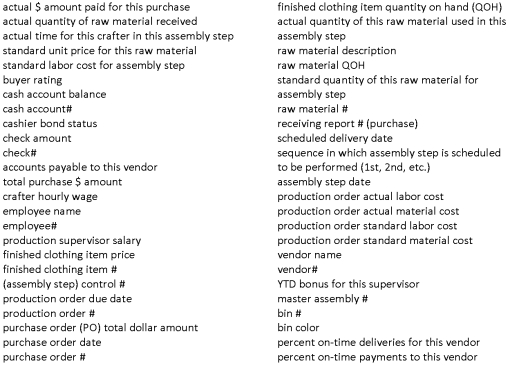Integrated Case
Serena's Tennis Togs,Inc.,was founded by one of the world famous women's tennis players to produce tennis and other sports clothing for the many women that appreciate Serena's unique fashion sense.Serena's Tennis Togs,Inc.(STTI)makes and markets multiple types of recreational clothing lines for women.This case focuses on STTI's acquisition/payment and conversion processes.
STTI Conversion cycle.When STTI gets an order from one of their distributors (sales orders are not modeled in this case),a manufacturing supervisor issues one or more production orders to authorize production of the clothing items.Each production order applies to only one finished clothing item.For cost accounting purposes,STTI determines the total standard labor and material cost for each production order.
STTI has carefully planned the material and labor required for each of its finished clothing items.Its master assembly plan specifies the sequence of steps (assembly operations)as well as the raw materials required to produce each finished clothing item.The master assembly plan also specifies the standard labor and material cost for each step.Each step in the master assembly plan is identified with a master assembly number.
The actual manufacturing process occurs in a series of assembly steps (each step is identified by control # in the production control records).Each step may use several types of material.STTI tracks the actual material and labor costs for each step in their production control records.STTI also tracks the total standard and actual costs for each production order.
The STTI manufacturing process employs two classes of employees: crafters and supervisors (model separately).Crafters get the raw materials from inventory and use them in the assembly steps.Each assembly step may involve several crafters,and crafters may work on several assembly steps.
The crafters are paid on an hourly basis.Production supervisors are paid salaries and bonuses.(Model them separately).
STTI Purchases.STTI's financial success depends on the quality of their products,so the company buys only the highest quality raw materials and follows a structured acquisition process.First,the buyers issue purchase orders to vendors for one or more required raw material items.Second,the vendor ships the products to STTI,and STTI records purchases upon receipt and acceptance of the items.In some cases,vendors fulfill several purchase orders with one shipment.
STTI takes advantage of all prompt payment discounts.If multiple vouchers are due to the same vendor on a certain day,the cashier combines those into one payment.STTI pays for each purchase in full,less any applicable discount,on the day that the payment is due.
After receipt and acceptance,each raw material item is stored in its designated bin to facilitate its issue to the production process,although each bin may hold several different types of raw material.Each bin is color-coded for easy identification.
General.All economic agents,resources,and types are put into the database before any relationships with other entities are instantiated.STTI tracks its employees in separate classes according to their particular job,although each internal agent is keyed by employee#.(So,don't model one Employee agent; model separate internal agents,e.g.,buyers,crafters,cashiers,supervisors.)
REQUIRED: 1)use the information above and the list of attributes below to draw a UML class diagram showing the classes,associations,and multiplicities,2)prepare a listing of the tables necessary to support STTI's processes using all the attributes.Name each table and clearly identify primary keys with PK and foreign keys with FK.List your tables in the following order: RESOURCES,EVENTS,AGENTS,TYPE IMAGES,and LINKING.Use only the following list of attributes (remember that there should be no classes without attributes).
Attributes

Correct Answer:
Verified
Resources
Cash ...
View Answer
Unlock this answer now
Get Access to more Verified Answers free of charge
Q2: Conversion labor costs become part of cost
Q5: Gateways can direct sequence flow to support
Q8: Which of the following types of business
Q8: Integrated Case
Gary Cooper (yes - that is
Q10: Which of the following best describes the
Q12: Which of the following is not a
Q13: A labor plan class would establish standard
Q15: Which of the following best describes the
Q17: Which of the following least reflects the
Q19: Business rules describe appropriate actions to take
Unlock this Answer For Free Now!
View this answer and more for free by performing one of the following actions

Scan the QR code to install the App and get 2 free unlocks

Unlock quizzes for free by uploading documents